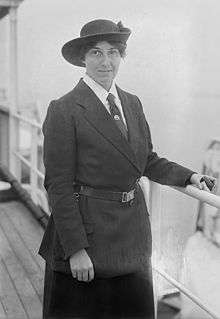Robert Baden-Powell, 1st Baron Baden-Powell
Lieutenant General Robert Stephenson Smyth Baden-Powell, 1st Baron Baden-Powell, OM, GCMG, GCVO, KCB, KStJ, DL (/ˈbeɪdən ˈpoʊəl/ BAY-dən POH-əl; 22 February 1857 – 8 January 1941), was a British Army officer, writer, founder and first Chief Scout of the world-wide Scout Movement, and founder, with his sister Agnes, of the world-wide Girl Guide / Girl Scout Movement. Baden-Powell authored the first editions of the seminal work Scouting for Boys, which was an inspiration for the Scout Movement.[4]
Lord Baden-Powell | |
|---|---|
.jpg) Robert Baden-Powell in 1896 | |
| Nickname(s) | B-P, Robin (by his wife)[1] |
| Born | 22 February 1857 Paddington, London, England |
| Died | 8 January 1941 (aged 83) Nyeri, British Kenya |
| Buried | St Peter's Cemetery, Nyeri, Kenya (0.418968°S 36.950117°E) |
| Allegiance | United Kingdom |
| Service/ | British Army |
| Years of service | 1876–1910 |
| Rank | Lieutenant General |
| Commands held |
|
| Battles/wars |
|
| Awards |
|
| Spouse(s) | Olave St Clair Soames |
| Children |
|
| Other work | Founder of the international Scouting Movement; writer; artist |
| Signature | |
Educated at Charterhouse School, Baden-Powell served in the British Army from 1876 until 1910 in India and Africa.[5] In 1899, during the Second Boer War in South Africa, Baden-Powell successfully defended the town in the Siege of Mafeking.[6] Several of his books, written for military reconnaissance and scout training in his African years, were also read by boys. In 1907, he held a demonstration camp, the Brownsea Island Scout camp, which is now seen as the beginning of Scouting.[7] Based on his earlier books, particularly Aids to Scouting, he wrote Scouting for Boys,[8] published in 1908 by Sir Arthur Pearson, for boy readership. In 1910 Baden-Powell retired from the army and formed The Scout Association.
The first Scout Rally was held at The Crystal Palace in 1909. Girls in Scout uniform attended, telling Baden-Powell that they were the "Girl Scouts". In 1910, Baden-Powell and his sister Agnes Baden-Powell started the Girl Guide and Girl Scout. In 1912 he married Olave St Clair Soames. He gave guidance to the Scout and Girl Guide movements until retiring in 1937. Baden-Powell lived his last years in Nyeri, Kenya, where he died and was buried in 1941. His grave is a national monument.[9]
Forebears
Baden-Powell's father was the Reverend Professor Baden Powell, a prominent mathematician and theologian, whose family originated in Suffolk.[10] His mother was Henrietta Grace, daughter of Admiral William Henry Smyth whose earliest known Smyth ancestor was a Royalist American colonist; her mother's father Thomas Warington was the British Consul in Naples around 1800.[11]
Early life
Baden-Powell was born as Robert Stephenson Smyth Powell at 6 Stanhope Street (now 11 Stanhope Terrace), Paddington, London, on 22 February 1857. He was called Stephe (pronounced "Stevie") by his family.[12] He was named after his godfather, Robert Stephenson, the railway and civil engineer,[13] and his third name was his mother's maiden name.[14]
Baden-Powell was a son of The Reverend Professor Baden Powell, Savilian Professor of Geometry at Oxford University and Church of England priest, and his third wife, Henrietta Grace Smyth (3 September 1824 – 13 October 1914), eldest daughter of Admiral William Henry Smyth. After the Rev. Prof. Powell died in 1860 his widow, to identify her children with her late husband's fame, and to set her own children apart from their half-siblings and cousins, styled the family name Baden-Powell. The name was eventually legally changed by Royal Licence on 30 April 1902.[15]
Baden-Powell had four older half-siblings from the second of his father's two previous marriages, and was the sixth child of his father's third marriage:[16]
- Warington (1847–1921)
- George (1847–1898)
- Augustus ("Gus") (1849–1863), who was often ill and died young
- Francis ("Frank") (1850–1933)
- Henrietta Smyth, 28 October 1851 – 9 March 1854, who died before B-P was born
- John Penrose Smyth, 21 December 1852 – 14 December 1855, who died before B-P was born
- Jessie Smyth 25 November 1855 – 24 July 1856, who died before B-P was born
- B-P (22 February 1857 – 8 January 1941)
- Agnes (1858–1945)
- Baden (1860–1937)
The three children immediately preceding B-P had all died very young before he was born.[12]
Baden-Powell's father died when he was three. Subsequently, Baden-Powell was raised by his mother, a strong woman who was determined that her children would succeed. In 1933 he said of her "The whole secret of my getting on, lay with my mother."[12][17][18]
Baden-Powell attended Rose Hill School, Tunbridge Wells. He was given a scholarship to Charterhouse, a prestigious public school named after the ancient a Carthusian monastery buildings it occupied in the City of London,[19] but while he was a pupil, the school moved out to new purpose-built premises in the countryside near Godalming in Surrey. He played the piano and violin, was an ambidextrous artist, and enjoyed acting. Holidays were spent on yachting or canoeing expeditions with his brothers. His first introduction to Scouting skills was through stalking and cooking game while avoiding teachers in the nearby woods, which were strictly out-of-bounds.[12]
Military career
In 1876 Baden-Powell joined the 13th Hussars in India with the rank of lieutenant. He enhanced and honed his military scouting skills amidst the Zulu in the early 1880s in the Natal province of South Africa, where his regiment had been posted, and where he was Mentioned in Despatches. Baden-Powell's skills impressed his superiors and in 1890 he was brevetted Major as Military Secretary and senior Aide-de-camp to the Commander-in-Chief and Governor of Malta, his uncle General Sir Henry Augustus Smyth.[12] He was posted to Malta for three years, also working as intelligence officer for the Mediterranean for the Director of Military Intelligence.[12] He frequently travelled disguised as a butterfly collector, incorporating plans of military installations into his drawings of butterfly wings.[20] In 1884 he published Reconnaissance and Scouting.[21]
.png)
Baden-Powell returned to Africa in 1896, and served in the Second Matabele War, in the expedition to relieve British South Africa Company personnel under siege in Bulawayo.[22] This was a formative experience for him not only because he commanded reconnaissance missions into enemy territory in the Matopos Hills, but because many of his later Boy Scout ideas took hold here.[23] It was during this campaign that he first met and befriended the American scout Frederick Russell Burnham, who introduced Baden-Powell to stories of the American Old West and woodcraft (i.e. Scoutcraft), and here that he was introduced for the first time to the Montana Peaked version of a western cowboy hat, of which Stetson was a prolific manufacturer, and which also came to be known as a campaign hat and the many versatile and practical uses of a neckerchief.[12]
Baden-Powell was accused of illegally executing a prisoner of war in 1896, the Matabele chief Uwini, who had been promised his life would be spared if he surrendered.[24] Uwini was sentenced to be shot by firing squad by a military court, a sentence Baden-Powell confirmed. Baden-Powell was cleared by a military court of inquiry but the colonial civil authorities wanted a civil investigation and trial. Baden-Powell later claimed he was "released without a stain on my character".[25]
After Rhodesia, Baden-Powell served in the Fourth Ashanti War in Gold Coast. In 1897, at the age of 40, he was brevetted colonel (the youngest colonel in the British Army) and given command of the 5th Dragoon Guards in India.[26] A few years later he wrote a small manual, entitled Aids to Scouting, a summary of lectures he had given on the subject of military scouting, much of it a written explanation of the lessons he had learned from Burnham, to help train recruits.[27]
.jpg)
Baden-Powell returned to South Africa before the Second Boer War and was engaged in further military actions against the Zulus. Although instructed to maintain a mobile mounted force on the frontier with the Boer Republics, Baden-Powell amassed stores and established a garrison at Mafeking. The subsequent Siege of Mafeking lasted 217 days. Although Baden-Powell could have destroyed his stores and had sufficient forces to break out throughout much of the siege, especially since the Boers lacked adequate artillery to shell the town or its forces, he remained in the town to the point of his intended mounted soldiers eating their horses. The town had been surrounded by a Boer army, at times in excess of 8,000 men.[28]
The siege of the small town received much attention from both the Boers and international media because Lord Edward Cecil, the son of the British Prime Minister, was besieged in the town.[29][30] The garrison held out until relieved, in part thanks to cunning deceptions, many devised by Baden-Powell. Fake minefields were planted and his soldiers pretended to avoid non-existent barbed wire while moving between trenches.[31] Baden-Powell did much reconnaissance work himself.[32] In one instance, noting that the Boers had not removed the rail line, Baden-Powell loaded an armoured locomotive with sharpshooters and sent it down the rails into the heart of the Boer encampment and back again in a successful attack.[30]
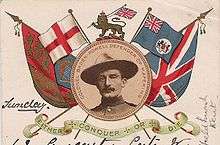
A contrary view expressed by historian Thomas Pakenham of Baden-Powell's actions during the siege argues that his success in resisting the Boers was secured at the expense of the lives of the native African soldiers and civilians, including members of his own African garrison. Pakenham stated that Baden-Powell drastically reduced the rations to the native garrison.[33] However, in 2001, after subsequent research, Pakenham decidedly retreated from this position.[12][29]
During the siege, the Mafeking Cadet Corps of white boys below fighting age stood guard, carried messages, assisted in hospitals, and so on, freeing grown men to fight. Baden-Powell did not form the Cadet Corps himself, and there is no evidence that he took much notice of them during the Siege. However, he was sufficiently impressed with both their courage and the equanimity with which they performed their tasks to use them later as an object lesson in the first chapter of Scouting for Boys.[34]
The siege was lifted on 16 May 1900. Baden-Powell was promoted to major-general and became a national hero.[35] However, British military commanders were more critical of his performance and even less impressed with his subsequent choices to again allow himself to be besieged.[30][33] Ultimately, his failure to properly understand the situation and abandonment of the soldiers, mostly Australians and Rhodesians, at the Battle of Elands River led to his being removed from action.[29][30]
Briefly back in the United Kingdom in October 1901, Baden-Powell was invited to visit King Edward VII at Balmoral, the monarch's Scottish retreat, and personally invested as Companion of the Order of the Bath (CB).[36]
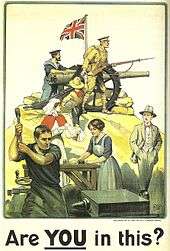
The South African War had seen the largest British Army ever to leave Britain, and with the end of that War on 31 May 1902 "active Service" effectively ceased. Baden-Powell was given the role of organising the South African Constabulary, a colonial police force,[30] but during this phase Baden-Powell was sent to Britain on sick leave, so was only in command for seven months.[30] He returned to England to take up a post as Inspector-General of Cavalry in 1903. While holding this position, Baden-Powell was instrumental in reforming reconnaissance training in British cavalry, giving the force an important advantage in scouting ability over continental rivals.[37] Also during this appointment, Baden-Powell selected the location of Catterick Garrison to replace Richmond Castle which was then the Headquarters of the Northumbrian Division. In 1907 he was promoted to Lieutenant-General but was left on the inactive list. Eventually he was appointed to the lowly command of the Northumbrian Division of the newly formed Territorial Force.[38]
On the outbreak of World War I in 1914, at the age of fifty-seven, Baden-Powell put himself at the disposal of the War Office. No command was given to him. Lord Kitchener said: "he could lay his hand on several competent divisional generals but could find no one who could carry on the invaluable work of the Boy Scouts".[39] In 1910, after being rebuked for a series of what were regarded as publicity gaffes, one suggesting invasion by Germany, Baden-Powell retired from the Army.[12] Baden-Powell later claimed he was advised by King Edward VII that he could better serve his country by promoting Scouting.[40][41]
Scouting Movement
Pronunciation of Baden-Powell
/ˈbeɪdən ˈpoʊəl/ BAY-dən POH-əl
Man, matron, maiden,
Please call it Baden.
Further for Powell,
Rhyme it with Noel
On his return from Africa in 1903, Baden-Powell found that his military training manual, Aids to Scouting, had become a best-seller, and was being used by teachers and youth organisations,[43] including Charlotte Mason's House of Education.[44] Following his involvement in the Boys' Brigade as a Brigade Vice-President and Officer in charge of its scouting section, with encouragement from his friend, William Alexander Smith, Baden-Powell decided to re-write Aids to Scouting to suit a youth readership. In August 1907 he held a camp on Brownsea Island to test out his ideas. About twenty boys attended: eight from local Boys' Brigade companies, and about twelve public school boys, mostly sons of his friends.[45]
Baden-Powell was also influenced by Ernest Thompson Seton, who founded the Woodcraft Indians. Seton gave Baden-Powell a copy of his book The Birch Bark Roll of the Woodcraft Indians and they met in 1906.[46][47] The first book on the Scout Movement, Baden-Powell's Scouting for Boys was published in six instalments in 1908, and has sold approximately 150 million copies as the fourth best-selling book of the 20th century.[48]

Boys and girls[49] spontaneously formed Scout troops and the Scouting Movement had inadvertently started, first as a national, and soon an international phenomenon.[50] A rally of Scouts was held at Crystal Palace in London in 1909, at which Baden-Powell met some of the first Girl Scouts. The Girl Guides were subsequently formed in 1910 under the auspices of Baden-Powell's sister, Agnes Baden-Powell. In 1912, Baden-Powell started a world tour with a voyage to the Caribbean. Another passenger was Juliette Gordon Low, an American who had been running a Guide Company in Scotland, and was returning to the U.S.A. Baden-Powell encouraged her to found the Girl Scouts of the USA.[51]
In 1920, the 1st World Scout Jamboree took place in Olympia in West Kensington, and Baden-Powell was acclaimed Chief Scout of the World. Baden-Powell was created a Baronet in 1921 and Baron Baden-Powell, of Gilwell, in the County of Essex, on 17 September 1929, Gilwell Park being the International Scout Leader training centre.[52] After receiving this honour, Baden-Powell mostly styled himself "Baden-Powell of Gilwell".[52]
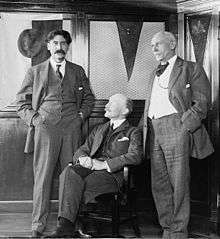
In 1929, during the 3rd World Scout Jamboree, he received as a present a new 20-horsepower Rolls-Royce car (chassis number GVO-40, registration OU 2938) and an Eccles Caravan.[53] This combination well served the Baden-Powells in their further travels around Europe. The caravan was nicknamed Eccles and is now on display at Gilwell Park. The car, nicknamed Jam Roll, was sold after his death by Olave Baden-Powell in 1945. Jam Roll and Eccles were reunited at Gilwell for the 21st World Scout Jamboree in 2007. Recently it has been purchased on behalf of Scouting and is owned by a charity, B-P Jam Roll Ltd. Funds are being raised to repay the loan that was used to purchase the car.[53][54]
Baden-Powell also had a positive impact on improvements in youth education.[55] Under his dedicated command the world Scouting Movement grew. By 1922 there were more than a million Scouts in 32 countries; by 1939 the number of Scouts was in excess of 3.3 million.[56]
Some early Scouting "Thanks Badges" (from 1911) and the Scouting "Medal of Merit" badge had a swastika symbol on them.[57][58] This was undoubtedly influenced by the use by Rudyard Kipling of the swastika on the jacket of his published books,[59] including Kim, which was used by Baden-Powell as a basis for the Wolf Cub branch of the Scouting Movement. The swastika had been a symbol for luck in India long before being adopted by the Nazi Party in 1920, and when Nazi use of the swastika became more widespread, the Scouts stopped using it.[57]
Nazi Germany banned Scouting, a competitor to the Hitler Youth, in June 1934, seeing it as "a haven for young men opposed to the new State".[60] Based on the regime's view of Scouting as a dangerous espionage organisation, Baden-Powell's name was included in "The Black Book", a 1940 list of people to be detained following the planned conquest of the United Kingdom.[61] A drawing by Baden-Powell depicts Scouts assisting refugees fleeing from the Nazis and Hitler.[62][63] Tim Jeal, author of the biography Baden-Powell, gives his opinion that "Baden-Powell's distrust of communism led to his implicit support, through naïveté, of fascism", an opinion based on two of B-P's diary entries. Baden-Powell met Benito Mussolini on 2 March 1933, and in his diary described him as "small, stout, human and genial. Told me about Balilla, and workmen's outdoor recreations which he imposed though 'moral force'". On 17 October 1939 Baden-Powell wrote in his diary: "Lay up all day. Read Mein Kampf. A wonderful book, with good ideas on education, health, propaganda, organisation etc. – and ideals which Hitler does not practice himself."[12]
At the 5th World Scout Jamboree in 1937, Baden-Powell gave his farewell to Scouting, and retired from public Scouting life. 22 February, the joint birthday of Robert and Olave Baden-Powell, continues to be marked as Founder's Day by Scouts and World Thinking Day by Guides to remember and celebrate the work of the Chief Scout and Chief Guide of the World.[64]
In his final letter to the Scouts, Baden-Powell wrote:
I have had a most happy life and I want each one of you to have a happy life too. I believe that God put us in this jolly world to be happy and enjoy life. Happiness does not come from being rich, nor merely being successful in your career, nor by self-indulgence. One step towards happiness is to make yourself healthy and strong while you are a boy, so that you can be useful and so you can enjoy life when you are a man. Nature study will show you how full of beautiful and wonderful things God has made the world for you to enjoy. Be contented with what you have got and make the best of it. Look on the bright side of things instead of the gloomy one. But the real way to get happiness is by giving out happiness to other people. Try and leave this world a little better than you found it and when your turn comes to die, you can die happy in feeling that at any rate you have not wasted your time but have done your best. "Be prepared" in this way, to live happy and to die happy – stick to your Scout Promise always – even after you have ceased to be a boy – and God help you to do it.[65]
Baden-Powell died on 8 January 1941: his grave is in St Peter's Cemetery in Nyeri, Kenya.[66] His gravestone bears a circle with a dot in the centre "ʘ", which is the trail sign for "Going home", or "I have gone home". His wife Olave moved back to England in 1942, although after she died in 1977, her ashes were taken to Kenya by her grandson Robert and interred beside her husband.[67] In 2001 the Kenyan government declared Baden-Powell's grave a National Monument.[68]
Writings and publications
| Library resources about Robert Baden-Powell |
| By Robert Baden-Powell |
|---|
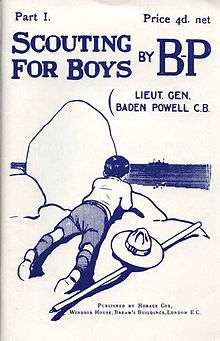
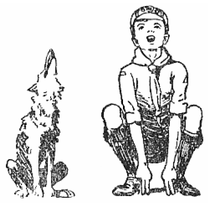
Baden-Powell published books and other texts during his years of military service both to finance his life and to generally educate his men.[12]
- 1884: Reconnaissance and Scouting
- 1885: Cavalry Instruction
- 1889: Pigsticking or Hoghunting
- 1896: The Downfall of Prempeh
- 1897: The Matabele Campaign
- 1899: Aids to Scouting for N.-C.Os and Men
- 1900: Sport in War
- 1901: Notes and Instructions for the South African Constabulary
- 1907: Sketches in Mafeking and East Africa
- 1910: British Discipline, Essay 32 of Essays on Duty and Discipline[69][70]
- 1914: Quick Training for War
Baden-Powell was regarded as an excellent storyteller. During his whole life he told "ripping yarns" to audiences. After having published Scouting for Boys, Baden-Powell kept on writing more handbooks and educative materials for all Scouts, as well as directives for Scout Leaders. In his later years, he also wrote about the Scout movement and his ideas for its future. He spent most of the last two years of his life in Africa, and many of his later books had African themes.[12]
- 1908: Scouting for Boys
- 1909: Yarns for Boy Scouts
- 1912: The Handbook for the Girl Guides or How Girls Can Help to Build Up the Empire (co-authored with Agnes Baden-Powell)
- 1913: Boy Scouts Beyond The Sea: My World Tour
- 1915: Indian Memories (American title Memories of India)
- 1915: My Adventures as a Spy[20]
- 1916: Young Knights of the Empire: Their Code, and Further Scout Yarns[71]
- 1916: The Wolf Cub's Handbook
- 1918: Girl Guiding
- 1919: Aids To Scoutmastership
- 1921: What Scouts Can Do: More Yarns
- 1921: An Old Wolf's Favourites
- 1922: Rovering to Success
- 1927: Life's Snags and How to Meet Them
- 1929: Scouting and Youth Movements
- est 1929: Last Message to Scouts[72]
- 1932: He-who-sees-in-the-dark; the Boys' Story of Frederick Burnham, the American Scout[73]
- 1933: Lessons From the Varsity of Life
- 1934: Adventures and Accidents
- 1935: Scouting Round the World
- 1936: Adventuring to Manhood
- 1937: African Adventures
- 1938: Birds and Beasts of Africa
- 1939: Paddle Your Own Canoe
- 1940: More Sketches Of Kenya
Most of his books (the American editions) are available online.[74]
Compilations and excerpts comprised:
- B.-P.'s Outlook: Selections from the Founder's contributions to "The Scouter" magazine from 1909–1940. C. Arthur Pearson Limited. 1955.
- Adventuring with Baden-Powell: Stories,yarns and essays. Blandford Press. 1956. ASIN B0000CJLLR.
- Dr. Mario Sica, ed. (2007). Playing the Game: A Baden-Powell Compendium. MacMillan. ISBN 978-1-4050-8827-5.
Baden-Powell also contributed to various other books, either with an introduction or foreword, or being quoted by the author,
- 1905: Ambidexterity by John Jackson[75]
- 1839: Fifty years against the stream: The story of a school in Kashmir, 1880–1930 by E.D. Tyndale-Biscoe about the Tyndale Biscoe School[76][75]
Art
Baden-Powell's father often sketched caricatures of those present at meetings, while his maternal grandmother was also artistic. Baden-Powell painted or sketched almost every day of his life. Most of his works have a humorous or informative character.[12] His books are scattered with his pen-and-ink sketches, frequently whimsical. He did a large unknown number of pen-and-ink sketches; he always travelled with a sketchpad that he used frequently for pencil sketches and "cartoons" for later water-colour paintings. He also created a few sculptures. There is no catalogue of his works, many of which appear in his books, and twelve paintings hang in the British Scout Headquarters at Gilwell Park. In 1911 and 1912, he had fishing holidays in Norway. There was an exhibition of his work at the Willmer House Museum, Farnham, Surrey, from 11 April – 12 May 1967; a text-only catalogue was produced.[77]
Personal life
In January 1912, Baden-Powell was en route to New York on a Scouting World Tour, on the ocean liner SS Arcadian, when he met Olave St Clair Soames.[78][79] She was 23, while he was 55; they shared the same birthday, 22 February. They became engaged in September of the same year, causing a media sensation due to Baden-Powell's fame. To avoid press intrusion, they married in private on 30 October 1912, at St Peter's Church in Parkstone.[80] 100,000 Scouts had each donated a penny to buy Baden-Powell a wedding gift, a 20 h.p. Standard motor-car (not the Rolls-Royce they were presented with in 1929).[81] There is a display about their marriage inside St Peter's Church, Parkstone.[82]
Baden-Powell and Olave lived in Pax Hill near Bentley, Hampshire from about 1919 until 1939.[83] The Bentley house was a gift from her father.[84] After they married, Baden-Powell began to suffer persistent headaches which were considered by his doctor to be psychosomatic, and which were treated with dream analysis.[12]

In 1939, Baden-Powell and Olave moved to a cottage he had commissioned in Nyeri, Kenya, near Mount Kenya, where he had previously been to recuperate. The small one-room house, which he named Paxtu, was located on the grounds of the Outspan Hotel, owned by Eric Sherbrooke Walker, Baden-Powell's first private secretary and one of the first Scout inspectors.[12] Walker also owned the Treetops Hotel, approximately 17 km out in the Aberdare Mountains, often visited by Baden-Powell and people of the Happy Valley set. The Paxtu cottage is integrated into the Outspan Hotel buildings and serves as a small Scouting museum.[85]
Baden-Powell's children and grandchildren were as follows:
- Robert Stephenson Smyth Baden-Powell (1857–1941), m. (1912) Olave St Clair Soames (1889–1977)[86]
- Arthur Robert Peter Baden-Powell (1913–1962) (later 2nd Baron Baden-Powell),[52] m. (1936) Carine Crause-Boardman
- Robert Crause Baden-Powell (1936–2019) (later 3rd Baron Baden-Powell)
- David Michael Baden-Powell (b. 1940) (now 4th Baron Baden-Powell)
- Wendy (b. 1944)
- Heather Grace Baden-Powell (1915–1986), m. (1940) John Hall King (1913–2004)
- Michael (1942–1966), who died in the sinking of SS Heraklion
- Timothy (1946–1995)
- Betty St Clair Baden-Powell[87] (1917–2004), m. (1936) Gervas Charles Robert Clay (1907–2009)[88]
- Gillian
- Robin
- Nigel
- Crispin
- Arthur Robert Peter Baden-Powell (1913–1962) (later 2nd Baron Baden-Powell),[52] m. (1936) Carine Crause-Boardman
In addition, when Olave's sister Auriol Davidson (née Soames) died in 1919, Olave and Robert took her three nieces, Christian (1912–1975), Clare (1913–1980), and Yvonne (1918–1995?), into their family and brought them up as their own children.[89]
Three of Baden-Powell's many biographers comment on his sexuality; the first two (in 1979 and 1986) focused on his relationship with his close friend Kenneth McLaren.[90]:217–218[91]:48 Tim Jeal's later (1989) biography discusses the relationship and finds no evidence that this friendship was of an erotic nature.[12]:82 Jeal then examines Baden-Powell's views on women, his appreciation of the male form, his military relationships, and his marriage, concluding that, in his personal opinion, Baden-Powell was a repressed homosexual.[12]:103 Jeal's arguments and conclusion are dismissed by Procter and Block (2009) as "amateur psychoanalysis", for which there is no physical evidence.[92]:6
Commissions and promotions
.jpg)
- Commissioned sub-lieutenant, 13th Hussars, 11 September 1876[93] (retroactively granted the rank of lieutenant from the same date on 17 September 1878[94])
- Captain, 13th Hussars, 16 May 1883[95]
- Major, 13th Hussars, 1 July 1892[97]
- Brevet lieutenant colonel, British Army, 25 March 1896[98]
- Lieutenant colonel, 13th Hussars, 25 April 1897[99]
- Major general, 23 May 1900[102]
- Inspector General of Cavalry, British Army
- Lieutenant general, 10 June 1907[103]
Recognition
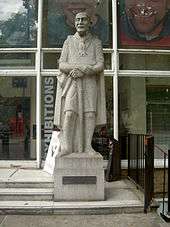
.jpg)
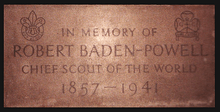
In 1937 Baden-Powell was appointed to the Order of Merit, one of the most exclusive awards in the British honours system, and he was also awarded 28 decorations by foreign states, including the Grand Officer of the Portuguese Order of Christ,[104] the Grand Commander of the Greek Order of the Redeemer (1920),[105] the Commander of the French Légion d'honneur (1925), the First Class of the Hungarian Order of Merit (1929), the Grand Cross of the Order of the Dannebrog of Denmark, the Grand Cross of the Order of the White Lion, the Grand Cross of the Order of the Phoenix, and the Order of Polonia Restituta.[106]
The Silver Wolf Award was originally worn by Robert Baden-Powell.[107] The Bronze Wolf Award, the only distinction of the World Organization of the Scout Movement, awarded by the World Scout Committee for exceptional services to world Scouting, was first awarded to Baden-Powell by a unanimous decision of the then International Committee on the day of the institution of the Bronze Wolf in Stockholm in 1935. He was also the first recipient of the Silver Buffalo Award in 1926, the highest award conferred by the Boy Scouts of America.[108]
In 1927, at the Swedish National Jamboree he was awarded by the Österreichischer Pfadfinderbund with the "Großes Dankabzeichen des ÖPB.[109]:113
In 1931 Baden-Powell received the highest award of the First Austrian Republic (Großes Ehrenzeichen der Republik am Bande) out of the hands of President Wilhelm Miklas.[109]:101 Baden-Powell was also one of the first and few recipients of the Goldene Gemse, the highest award conferred by the Österreichischer Pfadfinderbund.[110]
In 1931, Major Frederick Russell Burnham dedicated Mount Baden-Powell[111] in California to his old Scouting friend from forty years before.[112][113] Today, their friendship is honoured in perpetuity with the dedication of the adjoining peak, Mount Burnham.[114]
Baden-Powell was nominated for the Nobel Peace Prize on numerous occasions, including 10 separate nominations in 1928.[115] He was awarded the Wateler Peace Prize in 1937.[116] In 2002, Baden-Powell was named 13th in the BBC's list of the 100 Greatest Britons following a UK-wide vote.[117] As part of the Scouting 2007 Centenary, Nepal renamed Urkema Peak to Baden-Powell Peak.[118]
In June 2020, following the tearing down of Edward Colston's statue in Bristol by protesters in response to the killing of George Floyd, Bournemouth, Christchurch and Poole Council announced that a statue of Baden-Powell on Poole Quay would be removed temporarily for its protection, on police advice amid fears it was on a "target list for attack" by protestors because they believed that he held homophobic and racist views.[119]
Honours – United Kingdom
| Ribbon | Description | Notes |
| Ashanti Star | 1895 | |
| British South Africa Company Medal | 1896 | |
| Queen's South Africa Medal | 1896 | |
| Order of the Bath (CB) |
| |
| King's South Africa Medal |
| |
| Royal Victorian Order (KCVO) |
| |
| Order of the Bath (KCB) |
| |
| King George V Coronation Medal |
| |
| Venerable Order of St John (KStJ) |
| |
| Royal Victorian Order (GCVO) |
| |
| Baronet (BT) | ||
| Order of St Michael and St George (GCMG) |
| |
| Baron Baden-Powell, of Gilwell in the County of Essex |
| |
| King George V Silver Jubilee Medal |
| |
| Order of Merit (OM) |
| |
| King George VI Coronation Medal |
|
Honours – Other countries
| Ribbon | Description | Notes |
| Grand Officer of the Military Order of Christ (Portugal) |
| |
| Grand Commander of the Order of the Redeemer |
| |
| Grand Cross of the Order of the Dannebrog |
| |
| Grand Cross of the Order of the White Lion |
| |
| Knight of the Hungarian Order of Merit | ||
| Grand Cross of the Order of the Phoenix | ||
| Grand Cross of the Order of Orange-Nassau |
Arms
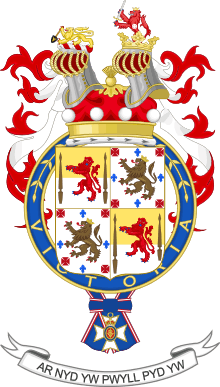 |
|
See also
- Baden-Powell's unilens
- Scouting memorials
Notes
- Chapter 8, end of first paragraph, "Window on my Heart" by Olave Baden-Powell as told to Mary Drewery, published by the Girl Guides Assoc, 1983
- "Silver Buffalo Awards". Boy Scouts of America. 2014. Archived from the original on 13 January 2014. Retrieved 24 January 2014.
- "The Library Headlines". ScoutBase UK. Archived from the original on 15 March 2005. Retrieved 2 December 2006.
- Deacon, Michael (8 January 2016). "The eccentric world of Robert Baden-Powell". The Telegraph. Telegraph Media Group Limited. Retrieved 21 February 2018.
- "Lord Baden Powell". Godalming Museum. Godalming Museum Trust. Retrieved 21 February 2018.
- Köhler, Karl (June 2001). "Some Aspects of Lord Baden-Powell and the Scouts at Modderfontein". Military History Journal. 12 (1). Retrieved 21 February 2018.
- "Scouting and Guiding on Brownsea Island". National Trust. National Trust. Retrieved 21 February 2018.
- Bond, Jenny; Sheedy, Chris (26 September 2009). "Forged in the Heat of Battle: The Origin of the Boy Scouts". Mental Floss. Mental Floss, Inc. Retrieved 21 February 2018.
- Wendell, Bryan (11 April 2014). "Scouting family takes pilgrimage to Baden-Powell's grave in Kenya". Bryan on Scouting.
- Edgar Powell (1891). "The Powell Pedigree". London: William Clowes and Sons, Limited. Retrieved 1 July 2019.
- The dispatches and letters of Vice Admiral Viscount Nelson. 6. Henry Colburn. 1846. p. 69.
- Jeal, Tim (1989). Baden-Powell. London: Hutchinson. ISBN 0-09-170670-X.
- "The life of Robert Stephenson — A Timeline". Robert Stephenson Trust. Archived from the original on 15 July 2011. Retrieved 13 October 2009.
- "The Scouting Pages". The Scouting Pages. 9 August 1907. Archived from the original on 26 March 2014. Retrieved 15 July 2014.
- Charles Mosley, ed. (1999). Burke's Peerage and Baronetage (106th ed.). Burke's Peerage (Genealogical Books) Ltd. p. 159.
- "The Powell Pedigree | Home". Archived from the original on 30 December 2017. Retrieved 29 December 2017.
- Palstra, Theo P. M. (April 1967). Baden-Powell, zijn leven en werk [Baden-Powell, His Life and Work, a True Story] (in Dutch). Den Haag: De Nationale Padvindersraad.
- Drewery, Mary (1975). Baden-Powell: The Man Who Lived Twice. London: Hodder & Stoughton. ISBN 0-340-18102-8.
- "The Charterhouse | Open House London 2019". openhouselondon.open-city.org.uk.
- Baden-Powell, Lieuth.-Gen. Sir Robert (1915). "My Adventures As A Spy". C. Arthur Pearson, Ltd. Archived from the original on 19 September 2017. Retrieved 24 December 2017.
- Baden-Powell, Robert (1884). Reconnaissance and scouting. A practical course of instruction, in twenty plain lessons, for officers, non-commissioned officers, and men. London: W. Clowes and Sons. OCLC 9913678.
- Baden-Powell, Robert (1897). The Matabele Campaign, 1896. Greenwood Press. ISBN 0-8371-3566-4.
- Proctor, Tammy M. (July 2000). "A Separate Path: Scouting and Guiding in Interwar South Africa". Comparative Studies in Society and History. 42 (3): 605–631. doi:10.1017/S0010417500002954. ISSN 0010-4175.
- Baden-Powell, Robert. "The Matabele Campaign". p. 104.
- Baden-Powell, Robert. "Lessons from the 'Varsity of Life". p. 90.
- Barrett, C.R.B. (1911). History of The XIII. Hussars. Edinburgh and London: William Blackwood and Sons. Archived from the original on 21 October 2006. Retrieved 2 January 2007.
- "First Scouting Handbook". Order of the Arrow, Boy Scouts of America. Archived from the original on 11 December 2013. Retrieved 30 July 2013.
- Hamilton, A. (2010). The Siege of Mafeking (1900). Kessinger Publishing. ISBN 978-1167298059.
- Pakenham, Thomas (2001). The Siege of Mafeking.
- Jeal, Tim (1989). Baden-Powell. London: Hutchinson. ISBN 0-09-170670-X.
- Latimer, Jon (2001). Deception in War. London: John Murray. pp. 32–35.
- Conan-Doyle, Arthur (1900). "Chapter 24. The Siege of Mafeking". The Great Boer War. Smith, Elder and Co.
- Pakenham, Thomas (1979). The Boer War. New York: Avon Books. ISBN 0-380-72001-9.
- Baden-Powell, Robert (1915). Scouting for Boys. C. Arthur Pearson.
- "Robert Baden-Powell: Defender of Mafeking and Founder of the Boy Scouts and the Girl Guides". Past Exhibition Archive. National Portrait Gallery, London. Archived from the original on 19 September 2011. Retrieved 2 November 2010.
- "Court circular". The Times (36585). London. 14 October 1901. p. 9.
- Jones, Spencer (2011). "Scouting for Soldiers: Reconnaissance and the British Cavalry, 1899–1914". War in History. 18 (4): 495–513. doi:10.1177/0968344511417348. Archived from the original on 3 December 2011. Retrieved 27 June 2012.
- Reported as "a Yorkshire division" in The Times, 29 October 1907, p.6; the Dictionary of National Biography lists it as the Northumbrian Division, which encompassed units from the North and East Ridings of Yorkshire as well as Northumbria proper.
- Saint George Saunders, Hilary (1948). "Chapter II, Enterprise, Lord Baden-Powell". The Left Handshake. Archived from the original on 14 December 2006. Retrieved 2 January 2007.
- Baden-Powell, Robert; Stephenson Smyth Baden-Powell Baden-Powell of Gilwell, Robert; Boehmer, Elleke (2005). Scouting for Boys: A Handbook for Instruction in Good Citizenship. Oxford University Press. p. lv. ISBN 978-0-19-280246-0. Archived from the original on 21 February 2018.
- "Lord Robert Baden-Powell "B-P" – Chief Scout of the World". The Wivenhoe Encyclopedia. Archived from the original on 3 October 2006. Retrieved 17 November 2006.
- Hillcourt, William (1964), Baden-Powell: The Two Lives of a Hero, New York: Putnam, p. 423
- Peterson, Robert (2003). "Marching to a Different Drummer". Scouting. Boy Scouts of America. Archived from the original on 18 May 2006. Retrieved 2 January 2007.
- "Transcript of 1937 interview with Powell". Archived from the original on 20 January 2007.
- "B.-P.'s Experimental camp on Brownsea Island" (PDF). The Scout Association. 1999. Archived from the original (PDF) on 4 July 2007. Retrieved 11 June 2007.
- "Ernest Thompson Seton and Woodcraft". InFed. 2002. Archived from the original on 8 December 2006. Retrieved 7 December 2006.
- "Robert Baden-Powell as an Educational Innovator". InFed. 2002. Archived from the original on 5 February 2007. Retrieved 7 December 2006.
- Extrapolation for global range of other language publications, and related to the number of Scouts, make a realistic estimate of 100 to 150 million books. Details from Jeal, Tim (1989). Baden-Powell. London: Hutchinson. ISBN 0-09-170670-X.
- Mills, Sarah (2011). "Scouting for Girls? Gender and the Scout Movement in Britain". Gender, Place & Culture. 18 (4): 537–556. doi:10.1080/0966369X.2011.583342.
- Mills, Sarah (2013). "'An instruction in good citizenship': scouting and the historical geographies of citizenship education". Transactions of the Institute of British Geographers. 38 (1): 120–134. doi:10.1111/j.1475-5661.2012.00500.x.
- Sims, Anastatia Hodgens; Keena, Katherine Knapp (Fall 2010). "Juliette Low's Gift: Girl Scouting in Savannah, 1912–1927". The Georgia Historical Quarterly. 94 (3): 372–387. JSTOR 20788992.CS1 maint: ref=harv (link)
- "Family history, Person". The Peerage. p. 876. Archived from the original on 30 December 2006. Retrieved 1 January 2007.
- "What ever happened to Baden-Powell's Rolls Royce?". Archived from the original on 20 August 2008. Retrieved 8 November 2008.
- ""Johnny" Walker's Scouting Milestones". 20 July 2008. Archived from the original on 28 February 2014. Retrieved 21 February 2014.
- "Baden-Powell as an Educational Innovator". Infed Thinkers. Archived from the original on 6 February 2006. Retrieved 4 February 2006.
- Nagy, László (1985). 250 million Scouts. Geneva: World Scout Foundation.
- Gresh, Lois H.; Weinberg, Robert (2008). Why Did It Have To Be Snakes: From Science to the Supernatural, The Many Mysteries of Indiana Jones. John Wiley & Sons. p. 127. ISBN 978-0-470-22556-1. Archived from the original on 8 January 2014. Retrieved 18 December 2013.
The symbol [swastika] was used on the Thanks Badge, created in 1911. The swastika had been a symbol for luck in India long before being adopted by the Nazis, and Baden-Powell would have come across it during his years serving in that country. In 1922, the swastika was incorporated into the design for the Medal of Merit. The symbol was dropped by the Boy Scouts in 1934 because of its use by the Nazi Party.
- "Boy Scout medal with fleur-de-lis and swastika, 1930s". The Learning Federation. Archived from the original on 23 July 2008. Retrieved 3 September 2008.
- "Origins of the swastika". 13 October 2017. Archived from the original on 4 March 2009 – via news.bbc.co.uk.
- Laqueur, Walter (1962). Young Germany: A History of the German Youth Movement. Transaction Books. pp. 201–202. ISBN 0-88738-002-6.
- Schellenberg, Walter (2000). Invasion, 1940: The Nazi Invasion Plan for Britain. Imperial War Museum. London: St Ermin's Press.
- "Scouting helps displaced people". scouts.org.uk. Retrieved 11 June 2020.
- "Evacuees and Refugees". Cambridge District Scout Archives. Retrieved 11 June 2020.
- WAGGGS. "World Thinking Day MDG 4 Activity Pack" (pdf). WAGGGS. p. 3. Retrieved 19 February 2013.
- Baden-Powell, Sir Robert. "B-P's final letter to the Scouts". Girl Guiding UK. Archived from the original on 23 November 2007. Retrieved 4 August 2007.
- ""B-P" – Chief Scout of the World". Baden-Powell. World Organization of the Scout Movement. Archived from the original on 30 September 2007.
- "Baden-Powell". www.scout.org. Archived from the original on 8 November 2015. Retrieved 1 August 2017.
- "Scouting family takes pilgrimage to Baden-Powell's grave in Kenya". Bryan on Scouting. 11 April 2014. Archived from the original on 8 September 2015.
- I. Maris, ed. (1910). Essays on Duty & Discipline. 32. London: Cassell & Co. Archived from the original on 24 April 2017.
- "Duty & Discipline | Home". www.spanglefish.com.
- Young Knights of the Empire: Their Code, and Further Scout Yarns at Project Gutenberg
- "B-P prepared a farewell message to his Scouts, for publication after his death". World Scouting. 1939.
- West, James E.; Lamb, Peter O. (1932). He-who-sees-in-the-dark; the Boys' Story of Frederick Burnham, the American Scout. illustrated by Lord Baden-Powell. New York: Brewer, Warren and Putnam; Boy Scouts of America.
- "Scout scan". the dump.
- Jackson (F.E.I.S.), John (1905). Ambidexterity, Or, Two-Handedness and Two-Brainedness. London: Kegan Paul, Trench, Trübner & Co. p. 258.
- Tyndale-Biscoe, E.D. (1930). Fifty years against the stream: The story of a school in Kashmir, 1880–1930. Mysore: Privately. p. 96.
- "Robert Baden-Powell | B-P the Artist". www.spanglefish.com.
- Baden-Powell, Olave. "Window on My Heart". The Autobiography of Olave, Lady Baden-Powell, G.B.E.as told to Mary Drewery. Hodder & Stoughton. Archived from the original on 21 October 2006. Retrieved 16 November 2006.
- "Fact Sheet: The Three Baden-Powell's: Robert, Agnes, and Olave" (PDF). Girl Guides of Canada. Archived from the original (PDF) on 9 March 2008.
- "Olave St Clair Baden-Powell (née Soames), Baroness Baden-Powell; Robert Baden-Powell, 1st Baron Baden-Powell". National Portrait Gallery, London. Archived from the original on 6 June 2011. Retrieved 16 November 2006.
- Hillcourt, p. 338
- "Friends of St Peter's | St Peter's Parkstone Parish Church".
- "Wey People, the Big Names of the Valley". Wey River freelance community. Archived from the original on 10 March 2007. Retrieved 29 April 2007.
- Wade, Eileen Kirkpatrick (1957). "5. Pax Hill". 27 Years with Baden-Powell. Blandford Press. Archived from the original on 30 December 2017. Retrieved 29 December 2017.
- "Why did Baden Powell choose Nyeri, Kenya as his last home?". Scouts. World Organization of the Scout Movement. 24 January 2014. Archived from the original on 5 June 2016. Retrieved 24 July 2016.
- "Olave Baden-Powell – Home". Archived from the original on 9 June 2017.
- "Betty Clay – Home". Archived from the original on 19 April 2016.
- "Gervas Clay – Home". Archived from the original on 6 March 2016.
- "Biography timeline". Retrieved 19 June 2020.
- Brendon, Piers (1979). Eminent Edwardians. Martin Secker & Warburg. ISBN 0-436-06810-9.
- Rosenthal, Michael (1986). The Character Factory: Baden-Powell and the Origins of the Boy Scout Movement. Pantheon Books. ISBN 0-394-51169-7.
- Block, Nelson R.; Proctor, Tammy M., eds. (2009). Scouting Frontiers: Youth and the Scout Movement's First Century. Newcastle upon Tyne: Cambridge Scholars Publishing. p. 6. ISBN 978-1-4438-0450-9.
- "London Gazette, 12 September 1876". Archived from the original on 1 February 2014.
- "London Gazette, 17 September 1878". Archived from the original on 1 February 2014.
- "London Gazette, 15 January 1884". Archived from the original on 1 February 2014.
- Jeal, Tim, 1989
- "London Gazette, 12 July 1892". Archived from the original on 1 February 2014.
- "London Gazette, 31 March 1896". Archived from the original on 1 February 2014.
- "London Gazette, 30 April 1897". Archived from the original on 9 November 2013.
- "London Gazette, 7 May 1897". Archived from the original on 1 February 2014.
- Baden-Powell, Robert. Lessons From the Varsity of Life, 1933. Retrieved from: https://www.pinetreeweb.com/bp-5th-dragoons.html
- "London Gazette, 22 May 1900". Archived from the original on 1 February 2014.
- "London Gazette, 11 June 1907". Archived from the original on 1 February 2014.
- "Supplement to the London Gazette". London Gazette. 1 June 1920. Archived from the original on 3 November 2012. Retrieved 17 June 2009.
- "Decoration Conferred by His Majesty the King of the Hellenes" (PDF). The London Gazette. 22 October 1920. Archived from the original (PDF) on 16 August 2011. Retrieved 10 February 2010.
- "Robert Baden-Powell Honours: Order of Polonia Restituta". Retrieved 13 June 2020.
- "Service Awards". historyofscouting.com. Retrieved 16 December 2016.
- "Silver Buffalo". Time. 10 May 1926.
- Pribich, Kurt (2004). Logbuch der Pfadfinderverbände in Österreich (in German). Vienna: Pfadfinder-Gilde-Österreichs.
- Wilceczek, Hans Gregor (1931). Georgsbrief des Bundesfeldmeisters für das Jahr 1931 an die Wölflinge, Pfadfinder, Rover und Führer im Ö.P.B. (in German). Vienna: Österreichischer Pfadfinderbund. p. 4.
- "Mount Baden-Powell". USGS. Retrieved 17 April 2006.
- Burnham, Frederick Russell (May 1931). "Dedication of Mount Baden-Powell". Archived from the original on 25 December 2017. Retrieved 24 December 2017.
- Burnham, Frederick Russell (1944). Taking Chances. Haynes. xxv–xxix. ISBN 1-879356-32-5.
- "Mapping Service". Mount Burnham. Retrieved 17 April 2006.
- "Nomination Database: Baden-Powell". The Nomination Database for the Nobel Peace Prize, 1901–1956. Archived from the original on 19 August 2011. Retrieved 2 November 2010.
- "Lijst van Laureaten van de Carnegie Wateler Vredesprijs". Archived from the original on 11 May 2015. Retrieved 11 July 2013.
- "BBC – Great Britons – Top 100". Internet Archive. Archived from the original on 4 December 2002. Retrieved 19 July 2017.
- "Rasuwa peak named after Baden Powell". The Himalayan Times. Retrieved 4 August 2012
- "Robert Baden-Powell: Scout founder statue to be removed in Poole". BBC News. 11 June 2020. Retrieved 11 June 2020.
- "London Gazette, 12 October 1909". Archived from the original on 1 February 2014.
- "London Gazette, 9 November 1909". Archived from the original on 1 February 2014.
- "London Gazette, 24 May 1912". Archived from the original on 1 February 2014.
- "London Gazette, 1 January 1923". Archived from the original on 1 February 2014.
- "London Gazette, 1 January 1921". Archived from the original on 1 February 2014.
- "London Gazette, 23 February 1923". Archived from the original on 1 February 2014.
- "London Gazette, 3 June 1927". Archived from the original on 1 February 2014.
- "London Gazette, 20 September 1929". Archived from the original on 1 February 2014.
- "London Gazette, 11 May 1937". Archived from the original on 29 October 2013.
- "London Gazette, 7 October 1919". Archived from the original on 1 February 2014.
- "London Gazette, 22 October 1920". Archived from the original on 1 February 2014.
- "London Gazette, 11 October 1921". Archived from the original on 1 February 2014.
- "Edinburgh Gazette, 12 November 1929". Archived from the original on 15 February 2017.
Related readings: biographies
- Begbie, Harold (1900). The story of Baden-Powell: The Wolf that never Sleeps. London: Grant Richards.
- Kiernan, R.H. (1939). Baden-Powell. London: Harrap.
- Saunders, Hilary St George (1948). The Left Handshake.
- Palstra, Theo P.M. (April 1967). Baden-Powel, zijn leven en werk (in Dutch). Den Haag: De Nationale Padvindersraad.
- Drewery, Mary (1975). Baden-Powell: the man who lived twice. London: Hodder & Stoughton. ISBN 0-340-18102-8.
- Brendon, Piers (1980). Eminent Edwardians. Houghton Mifflin Company. ISBN 0-395-29195-X.
- Jeal, Tim (1989). Baden-Powell. London: Hutchinson. ISBN 0-09-170670-X.
- Hillcourt, William; Baden-Powell, Olave (1992). Baden-Powell: The Two Lives Of A Hero. New York: Gilwellian Press d/b/a Scouter's Journal Magazine. ISBN 0-8395-3594-5.
- Maxence, Philippe (2003). Baden-Powell, éclaireur de légende et fondateur du scoutisme (in French). Perrin.
- Warren, Allen (2008) [2004]. "Powell, Robert Stephenson Smyth". Oxford Dictionary of National Biography (online ed.). Oxford University Press. doi:10.1093/ref:odnb/30520. (Subscription or UK public library membership required.)
- Maxence, Philippe (2016). Baden-Powell (in French). Perrin.
External links

- Works by Robert Baden-Powell, 1st Baron Baden-Powell at LibriVox (public domain audiobooks)

- Works by Robert Baden-Powell, 1st Baron Baden-Powell at Project Gutenberg
- "The American editions of Baden-Powell's books on line".
- Works by or about Robert Baden-Powell, 1st Baron Baden-Powell at Internet Archive
- Newspaper clippings about Robert Baden-Powell, 1st Baron Baden-Powell in the 20th Century Press Archives of the ZBW
- "Lord Baden Powell papers], digital repository". Harold B. Lee Library. Brigham Young University.
L. Tom Perry Special Collections
| Military offices | ||
|---|---|---|
| New title | General Officer Commanding Northumbrian Division 1908–1910 |
Succeeded by Francis Plowden |
| Peerage of the United Kingdom | ||
| New title | Baron Baden-Powell 1929–1941 |
Succeeded by Peter Baden-Powell |
| Baronetage of the United Kingdom | ||
| New title | Baronet (of Bentley) 1922–1941 |
Succeeded by Peter Baden-Powell |
| Scouting | ||
| New title | Chief Scout of the British Empire 1908–1941 |
Succeeded by Lord Somers |
| New title | Chief Scout of the World 1920–1941 |
Never assigned again |
